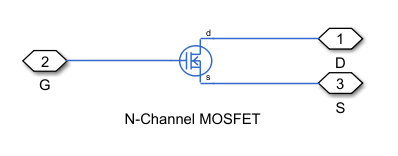generateSemiconductorSwitchROM
Syntax
Description
The generateSemiconductorSwitchROM function converts a
high-fidelity semiconductor switch subsystem into a MOSFET
(Ideal, Switching) or IGBT (Ideal,
Switching) block, which represents a reduced-order model (ROM). The function
parameterizes the ROM with the on-state tabulated I-V curve and tabulated switching losses for
the transistor, and the on-state tabulated I-V curve and tabulated reverse recovery loss for
the associated body or external diode.
The semiconductor switch in the high-fidelity subsystem can be an N-Channel
MOSFET block, an N-Channel
IGBT block, a SPICE-Imported
MOSFET block, or a black-box semiconductor model. The subsystem must include
a body diode or an external diode associated with the semiconductor switch. The
generateSemicondutorSwitchROM function uses a double-pulse test circuit
to extract the switching losses. The test harness is a single-quadrant chopper that supplies
an inductive load. The function requires a diode for the IGBT or MOSFET devices as a
free-wheeling diode because, in many applications such as three-phase AC motor drives,
bi-directional DC motor drives, and full-bridge DC-DC converters, the power electronics
converter comprises one or more IGBT-based half-bridges.
ROMs are easier to interpret and run faster than high-fidelity semiconductor switch subsystems. You can run faster simulations by replacing the original semiconductor switch subsystem with the generated ROM subsystem. Use ROMs to quickly test and analyze system-level scenarios where the semiconductor switch interacts with other systems.
generateSemiconductorSwitchROM( generates
a reduced-order model from the high-fidelity semiconductor switch subsystem
sys)sys.
generateSemiconductorSwitchROM(
specifies options using one or more name-value arguments in addition to the input argument
in the previous syntax. For example,
sys,Name=Value)generateSemiconductorSwitchROM(sys,OnStateGateSourceVoltage=20)
generates a ROM with an on-state gate-source voltage equal to 20 V.
Some of the name-value arguments are the test-circuit conditions. You can set these values based on your detailed circuit conditions or a datasheet. These values are optional but accurate test circuit conditions provide you with more accurate ROMs
ROMParameters = generateSemiconductorSwitchROM(sys,Name=Value)
Examples
Input Arguments
Name-Value Arguments
Output Arguments
Version History
Introduced in R2024b


![Figure contains an axes object. The axes object with title Diode I-V Characteristics by Temperature, xlabel Diode forward voltage V indexOf f baseline [V], ylabel Diode forward current I indexOf f baseline [A] contains 2 objects of type line. These objects represent Tj = 25 degC, Tj = 75 degC.](../../examples/simscapeelectrical/win64/GenerateROMOfThresholdBasedMOSFETExample_03.png)
![Figure Eon contains 2 axes objects. Axes object 1 with title Turn-On Switching Loss (Eon) at Tj = 25 [degC], xlabel On-state current [A], ylabel Energy loss (Eon) [J] contains 2 objects of type line. These objects represent Off-state voltage = 84.2902 [V], Off-state voltage = 104.2902 [V]. Axes object 2 with title Turn-On Switching Loss (Eon) at Tj = 75 [degC], xlabel On-state current [A], ylabel Energy loss (Eon) [J] contains 2 objects of type line. These objects represent Off-state voltage = 84.2902 [V], Off-state voltage = 104.2902 [V].](../../examples/simscapeelectrical/win64/GenerateROMOfThresholdBasedMOSFETExample_04.png)
![Figure Eoff contains 2 axes objects. Axes object 1 with title Turn-Off Switching Loss (Eoff) at Tj = 25 [degC], xlabel On-state current [A], ylabel Energy loss (Eoff) [J] contains 2 objects of type line. These objects represent Off-state voltage = 84.2902 [V], Off-state voltage = 104.2902 [V]. Axes object 2 with title Turn-Off Switching Loss (Eoff) at Tj = 75 [degC], xlabel On-state current [A], ylabel Energy loss (Eoff) [J] contains 2 objects of type line. These objects represent Off-state voltage = 84.2902 [V], Off-state voltage = 104.2902 [V].](../../examples/simscapeelectrical/win64/GenerateROMOfThresholdBasedMOSFETExample_05.png)
![Figure Erec contains 2 axes objects. Axes object 1 with title Reverse Recovery Loss (Erec) at Tj = 25 [degC], xlabel Complementary switch initial current [A], ylabel Energy loss (Erec) [J] contains 2 objects of type line. These objects represent Off-state voltage = 80 [V], Off-state voltage = 100 [V]. Axes object 2 with title Reverse Recovery Loss (Erec) at Tj = 75 [degC], xlabel Complementary switch initial current [A], ylabel Energy loss (Erec) [J] contains 2 objects of type line. These objects represent Off-state voltage = 80 [V], Off-state voltage = 100 [V].](../../examples/simscapeelectrical/win64/GenerateROMOfThresholdBasedMOSFETExample_06.png)